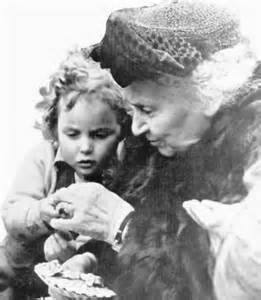 Is Montessori the right early educational experience for your child? If you’re not sure what to expect from this type of learning environment, how the overall philosophy can help your child, or how it became a leading educational option, take a look at the timeline of the Montessori method and how it connects to modern day child development programs.
Is Montessori the right early educational experience for your child? If you’re not sure what to expect from this type of learning environment, how the overall philosophy can help your child, or how it became a leading educational option, take a look at the timeline of the Montessori method and how it connects to modern day child development programs.
The Early Days
Montessori is an educational philosophy with a long history. Dr. Maria Montessori opened her first Casa dei Bambini (which translates to Children’s House) in January of 1907. Located in the inner-city San Lorenzo area of Rome, the Children’s House initially served children who didn’t have the financial means to attend another formal schooling program.
Not only did Dr. Montessori’s Children’s House help the children it served, but the children also helped the educational researcher to explore learning behaviors, child development, and early school experiences.
Through observational methods, Dr. Montessori was able to create a quality educational setting with accompanying materials that helped young children to learn and grow in new ways. By the end of 1907, Dr. Montessori had opened three Children’s Houses in Rome.
The Next Steps
Dr. Montessori’s scholastic success didn’t stay in Rome. Over the next century, the researcher’s philosophy-based schools spread across the globe. While her first American schools were popular among early twentieth-century parents, the philosophy fell out of fashion by the 1920s. But this wasn’t the end of the Montessori educational method in the United States.
Decades later in the mid-twentieth century, Montessori’s schools had a resurgence in America. Unlike the early years of Montessori, the philosophy didn’t fade in the U.S. education system. Instead, it flourished and the schools grew in number.
Modern Montessori Education
Even though the modern educational landscape may look different than it did over a century ago when Dr. Montessori founded the first Children’s House, the Montessori philosophy is still firmly grounded in the researcher’s early methods.
How do these methods differ from other contemporary classroom strategies or philosophies? The primary differences include:
- The history. While the history of Dr. Montessori’s method is interesting to learn about, it’s more than just a researcher’s story. The century-plus use around the globe shows the success of this educational philosophy.
- The multi-age classroom. Instead of individual classrooms for each age or grade level, the Montessori method uses a multi-age approach. This means your preschooler will stay in the same classroom from ages three through six. This creates a caring community and increases the continuity of learning.
- The self-directed activities. Dr. Montessori stressed the importance of self-directed learning. This departs from the traditional teacher-led model you would see in other types of programs.
- The materials. Dr. Montessori used the early twentieth-century classrooms of her Children’s House programs to learn more about how young students develop and what types of materials they should use. The result was a set of specially created materials that are still in use today.
- The uninterrupted work period. Dr. Montessori included an uninterrupted work period in her educational method. While other programs use a standardized activity-after-activity type of approach, the Montessori philosophy gives young children the chance to explore on their own time – minus disruptions from a teacher or an organized activity.
Dr. Maria Montessori may have started her educational research more than a century ago, but this doesn’t mean her methods are any less relevant in today’s classrooms. To get a better understanding of how this historical philosophy can impact your child’s learning, visit a Montessori program to see Dr. Montessori’s work in action.
Are you ready to learn more about Montessori preschool? Contact Miniapple International Montessori School for more information.

